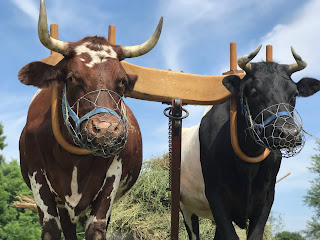 |
| 8, 7, and 5 inch yokes hanging on pegs on a "yoke tree" made from 2 by 3 cherry. |
Got a feed question? They'll happily help.
Yoke fit? They'll come on over and get ya set.
Cattle health concern? They've got three stories about a homemade cure and one about their trusty vet's advice.
Bulls hauling out? They've got three things to try, one that worked for grandpa, one they tried, and one
 |
| 9" double yoke out of the way, with the bow doing service in the 10" single yoke. |
Mower not adjusted right? They've got an extra copy of the manual tucked away for you, a checklist they used when they rebuilt one last season and the links to the three best Youtube videos to consult.
Need an old picture identified? Oh, please. Not only do they know the grand-niece of the guy in the photo, she won a blue ribbon two summers ago in the fair in the next town.
 |
| The 10" yoke rack. I'm not sure it must be a 2-year-old bale of hay, but that's what I use. |
Broken bow? They'll drop it off tonight, so you can get back to the woods tomorrow.
However. . .
Ask about yoke storage? Crickets.
Kesi mardana-Dasa fell into that trap a few weeks
 |
| Pegs in the yoke tree. |
A couple of years ago, I asked MODA folks, looking for content for the newsletter, about how they house their animals. . . Nothing. Bueller? Bueller?
I have a couple of hypotheses about this. Either:
 |
| Halters on the left, lead ropes on the right. Hooks from a garage sale. . .I think. |
1. We oxen people are a bit embarrassed that the barn is messier than we'd like.
or
2. The barn is pretty nice and oxen people don't want to seem braggadocious.
No matter, I'd be glad to start the group therapy session right here. Sprinkled throughout are photos of the barn. No clean up, cropping, or special lighting. Not too impressive, but I'm ok with that. Perfection is a hobby I don't plan to pursue.
 |
| Rakes on pegs, near pegs, and within spitting distance of pegs. |
We'd love to see your yokes and housing. We won't judge.














































